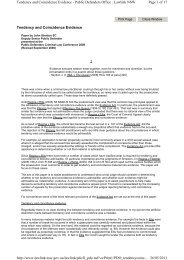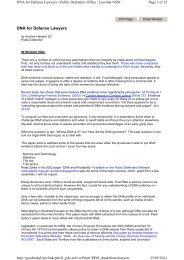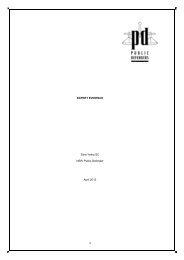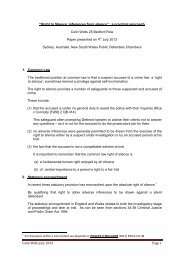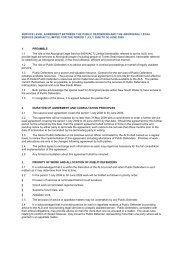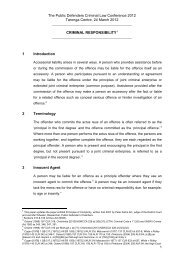DNA for NJC - The Public Defenders
DNA for NJC - The Public Defenders
DNA for NJC - The Public Defenders
You also want an ePaper? Increase the reach of your titles
YUMPU automatically turns print PDFs into web optimized ePapers that Google loves.
In some of the commentary on the recent UK decision in R v T 61 there was talk of a “clash<br />
between law and science” following the court’s rejection of the use of Bayes’ theorem in a<br />
criminal trial. To address Dr Walsh’s questions would require a separate paper but it is must<br />
be understood that criminal investigation is not like CSI on TV or a Patricia Cornwall novel,<br />
lawyers don’t want experts to decide based on all the evidence who is guilty no matter<br />
whether their analysis is Bayesian or not. That’s why we have police, prosecutors, juries and<br />
judges. “All we want are the facts.” 62 That is, enough facts to determine the source of the<br />
incrimination evidence. We also want a clear explanation of the scientific facts: 63 And, if<br />
there is a controversy, the nature of that controversy. <strong>The</strong>re is no clash between law and<br />
science. <strong>The</strong> law could do with more science and <strong>for</strong>ensic science could do with a little more<br />
legal rigour. but one way of reducing the risk of misunderstanding is to avoid adding<br />
complexity where it is does not serve any interest at trial.<br />
Simplifying the presentation of <strong>DNA</strong> evidence in criminal courts:<br />
Since <strong>DNA</strong> evidence was first used in court judges have been saying: “<strong>The</strong> statistical<br />
evidence interpreting the significance of the <strong>DNA</strong> match is not evidence of the probability the<br />
accused was the source of the incriminating <strong>DNA</strong>”. 64 Nevertheless, there is still a lot of time<br />
wasted and confusion about testing in court what is really indisputable. This can mean not<br />
enough time is spent on examining maters of real importance such as how did the accused’s<br />
<strong>DNA</strong> profile get to the crime scene.<br />
Law en<strong>for</strong>cement agencies have spent huge amounts of money increasing the size of<br />
databases. While this may increase the possibility of a cold hit I have since I was first<br />
involved in drafting the Forensic procedure Act had my doubts. Now we have such large<br />
databases the chance of an adventitious match is correspondingly increased. One response<br />
is to increase the discriminating power of the test and look at 13 or 21 loci. But if a Profiler<br />
Plus 9 loci “match” is not evidence of uniqueness, and the bigger the data base the greater<br />
the chance of a match all I suggest flows from this that guilt beyond reasonable doubt cannot<br />
be established solely by a profile match (even if accompanied by extraordinarily high<br />
statistics). This has and I suggest will remain the case until each of our individual genomes<br />
is sequenced. Accordingly there is scope <strong>for</strong> general agreement about how evidence of <strong>DNA</strong><br />
profile matching is to be presented in court?<br />
61 [2010] EWCA Crim 2439.<br />
62 Wikepedia tells us that this is what Sgt Joe Friday actually said, although I still prefer “the facts mam, just the facts.”<br />
63 I once had a traumatic experience of having asked the question of an expert “Now Professor could you explain that in simple<br />
terms” receiving the only simple answer of the day, “No”.<br />
64 Doyle CJ in R v Karger (2002) 83 SASR 135 at 140.<br />
16



